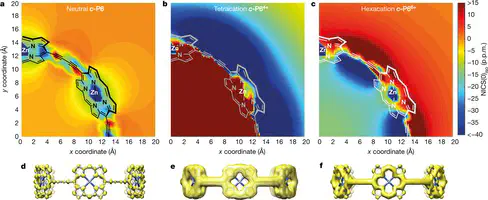
Abstract
Aromatic and antiaromatic molecules—which have delocalized circuits of [4n + 2] or [4n] electrons, respectively—exhibit ring currents around their perimeters1,2,3,4. The direction of the ring current in an aromatic molecule is such as to generate a magnetic field that opposes the external field inside the ring (a ‘diatropic’ current), while the ring current in an antiaromatic molecule flows in the reverse direction (‘paratropic’)5. Similar persistent currents occur in metal or semiconductor rings, when the phase coherence of the electronic wavefunction is preserved around the ring6,7. Persistent currents in non-molecular rings switch direction as a function of the magnetic flux passing through the ring, so that they can be changed from diatropic (‘aromatic’) to paratropic (‘antiaromatic’) simply by changing the external magnetic field. As in molecular systems, the direction of the persistent current also depends on the number of electrons8. The relationship between ring currents in molecular and non-molecular rings is poorly understood, partly because they are studied in different size regimes: the largest aromatic molecules have diameters of about one nanometre, whereas persistent currents are observed in microfabricated rings with diameters of 20–1,000 nanometres. Understanding the connection between aromaticity and quantum-coherence effects in mesoscopic rings provides a motivation for investigating ring currents in molecules of an intermediate size9. Here we show, using nuclear magnetic resonance spectroscopy and density functional theory, that a six-porphyrin nanoring template complex, with a diameter of 2.4 nanometres, is antiaromatic in its 4+ oxidation state (80 π electrons) and aromatic in its 6+ oxidation state (78 π electrons). The antiaromatic state has a huge paramagnetic susceptibility, despite having no unpaired electrons. This work demonstrates that a global ring current can be promoted in a macrocycle by adjusting its oxidation state to suppress the local ring currents of its components.The discovery of ring currents around a molecule with a circumference of 7.5 nanometres, at room temperature, shows that quantum coherence can persist in surprisingly large molecular frameworks.